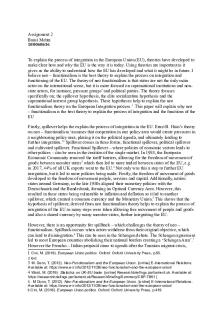Malinowski Functionalism: British Social Anthropology PDF

| Title | Malinowski Functionalism: British Social Anthropology |
|---|---|
| Course | Social Anthropology |
| Institution | University of Kent |
| Pages | 2 |
| File Size | 73.5 KB |
| File Type | |
| Total Downloads | 8 |
| Total Views | 122 |
Summary
Notes...
Description
Malinowski functionalism: http://anthropology.ua.edu/cultures/cultures.php?culture=Functionalism Malinowski was one of the founding fathers of British social anthropology. Functionalists seek to describe the different parts of a society and their relationship through the organic analogy. With Radcliffe-Brown, Malinowski pushed for a paradigm shift in British anthropology; a change from the speculative and historical to the ahistorical study of social institutions. This theoretical shift gave rise to functionalism and established fieldwork as the constitutive experience of social anthropology (Kuper 1973, Young 1991). Malinowski's functionalism was highly influential in the 1920s and 1930s. As applied methodology, this approach worked, except for situations of social or cultural change. While elements of Malinowski’s theory remain intact in current anthropological theory, it has changed from its original form with new and shifting paradigms (Young 1991:445). However, Malinowski made his greatest contribution as an ethnographer. He emphasized the importance of studying social behavior and social relations in their concrete cultural contexts through participant-observation. He considered it crucial to consider the observable differences between norms and action; between what people say they do and what they actually do. His detailed descriptions of Trobriand social life and thought are among the most comprehensive in world ethnography and his Argonauts of the Western Pacific (1922) is one of the most widely read works of anthropology. Malinowski's enduring conceptual contributions lay in the areas of: kinship and marriage (e.g., the concept of "sociological paternity"); in magic, ritual language and myth (e.g., the idea of "myth as social charter"); and in economic anthropology (notably the concept of "reciprocity") (Young 1991:445). Organic analogy: functionalists use an ‘organic analogy’ to compare society to the human body. They argue that all parts of society need to work together in order for society to maintain consensus – e.g.: if one organ is damaged in some way, the analogy assumes that all other organs would be impacted. An example in society would be if the education system was failing it would affect many other parts of society for instance, the workplace. The term means viewing society has having the same functions as a biological organism. Every aspect of society has its own function that is vital to the entire process. The ‘living organism’ is able to live, reproduce and function through the organized system of its several parts and organs. Like a biological organism, a society was able to maintain its essential processes through the way that the different parts interacted together. Institutions such as religion, kinship and the economy were the organs and individuals were the cells in this social organism. Functionalists analyse the social significance of a phenomena – the FUNCTION that they serve in a particular society thus maintaining the whole.
Malinowski suggested that individuals have physiological needs (reproduction, food, shelter) and that social institutions exist to meet these needs. There are also culturally derived needs and four basic "instrumental needs" (economics, social control, education, and political organization), that require institutional devices. Each institution has personnel, a charter, a set of norms or rules, activities, material apparatus (technology), and a function. Malinowski argued that uniform psychological responses are correlates of physiological needs. He argued that satisfaction of these needs transformed the cultural instrumental activity into an acquired drive through psychological reinforcement. The primary starting points of Malinowski's theorizing included: 1) understanding behavior in terms of the motivation of individuals, including both rational, 'scientifically' validated behavior and 'irrational', ritual, magical, or religious behavior; 2) recognizing the interconnectedness of the different items which constituted a 'culture' to form some kind of system; and 3) understanding a particular item by identifying its function in the current contemporary operation of that culture...
Similar Free PDFs

Functionalism
- 8 Pages

L1 Functionalism and the Family
- 2 Pages

Práctica Madagascar - Malinowski
- 2 Pages

Criminology and functionalism
- 3 Pages

Form v functionalism
- 2 Pages

Herbert Spencer\'s Functionalism
- 4 Pages

British Constitution
- 8 Pages
Popular Institutions
- Tinajero National High School - Annex
- Politeknik Caltex Riau
- Yokohama City University
- SGT University
- University of Al-Qadisiyah
- Divine Word College of Vigan
- Techniek College Rotterdam
- Universidade de Santiago
- Universiti Teknologi MARA Cawangan Johor Kampus Pasir Gudang
- Poltekkes Kemenkes Yogyakarta
- Baguio City National High School
- Colegio san marcos
- preparatoria uno
- Centro de Bachillerato Tecnológico Industrial y de Servicios No. 107
- Dalian Maritime University
- Quang Trung Secondary School
- Colegio Tecnológico en Informática
- Corporación Regional de Educación Superior
- Grupo CEDVA
- Dar Al Uloom University
- Centro de Estudios Preuniversitarios de la Universidad Nacional de Ingeniería
- 上智大学
- Aakash International School, Nuna Majara
- San Felipe Neri Catholic School
- Kang Chiao International School - New Taipei City
- Misamis Occidental National High School
- Institución Educativa Escuela Normal Juan Ladrilleros
- Kolehiyo ng Pantukan
- Batanes State College
- Instituto Continental
- Sekolah Menengah Kejuruan Kesehatan Kaltara (Tarakan)
- Colegio de La Inmaculada Concepcion - Cebu








